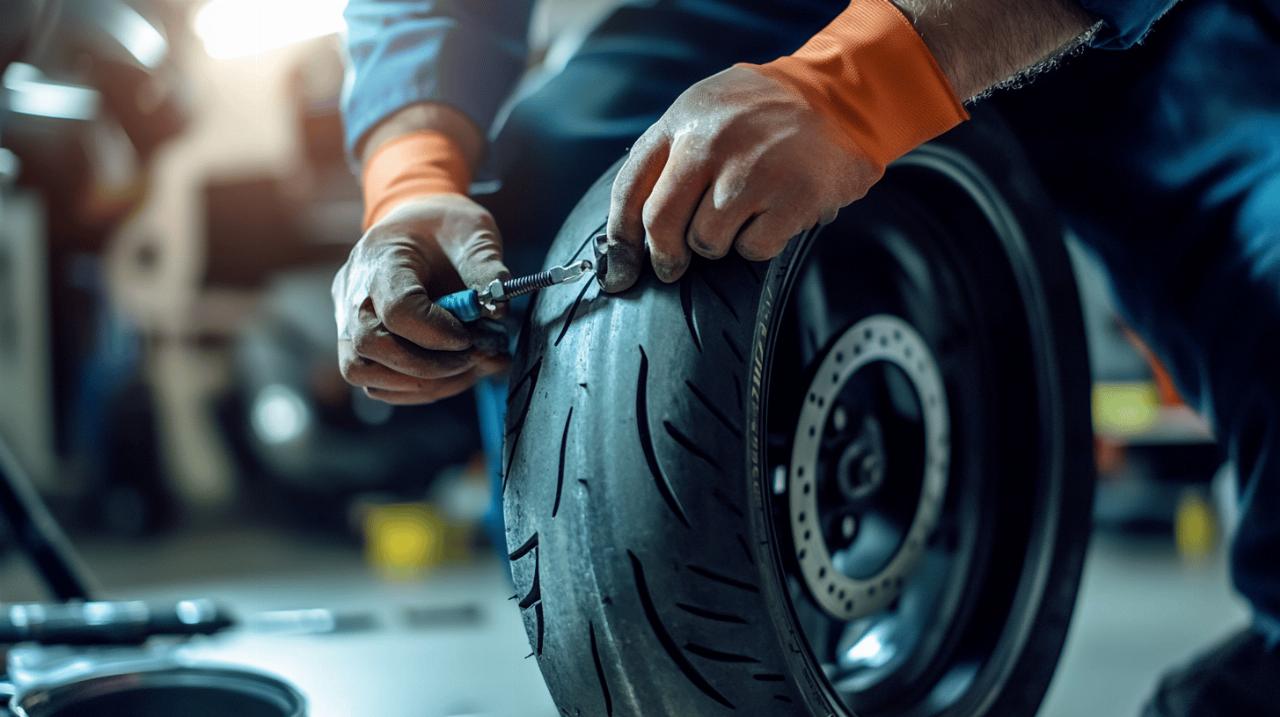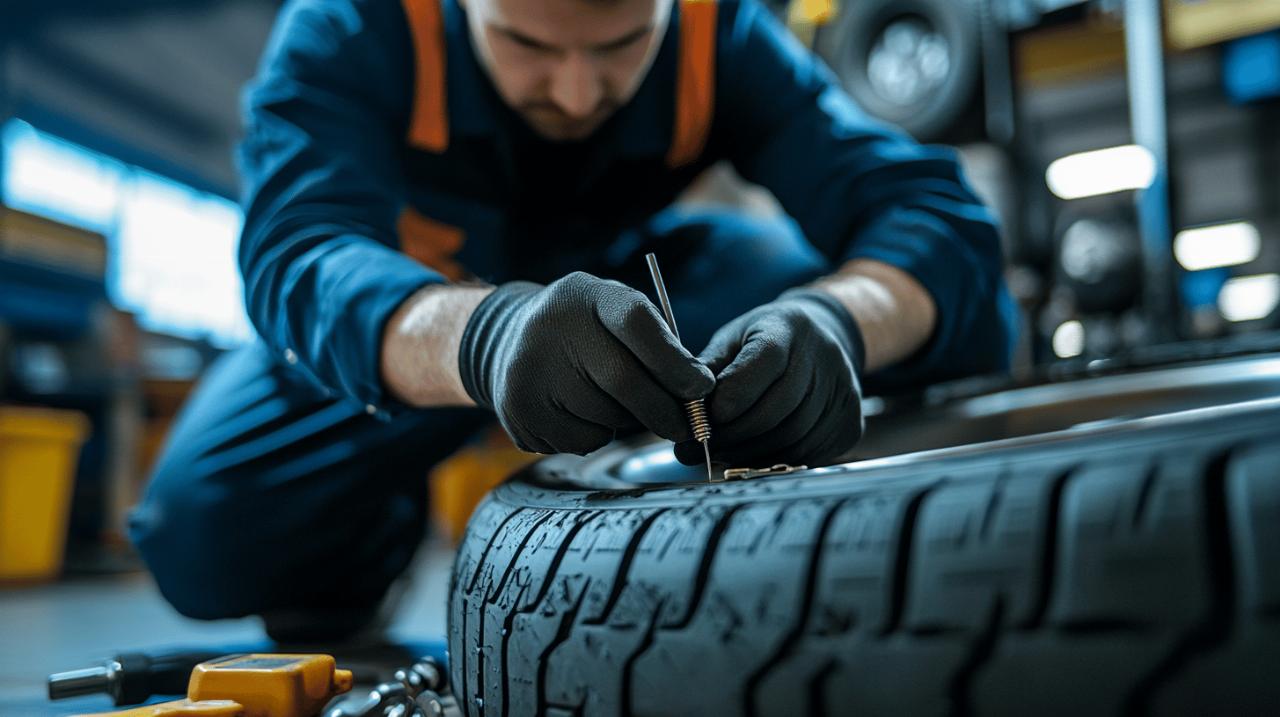Whether you're navigating the congested streets of central London or weaving through the urban sprawl of Manchester, punctures are an unavoidable reality for motorcyclists. The relentless stop-start nature of city riding exposes tyres to a myriad of hazards, from errant screws to shards of glass. Understanding how to use tyre sealant strips effectively can transform a roadside disaster into a manageable inconvenience, allowing you to reach safety or professional assistance without the stress of being stranded.
Understanding tyre sealant strips: your emergency puncture solution for urban riding
What are tyre sealant strips and when should you use them?
Tyre sealant strips, often referred to colloquially as worms due to their appearance, are rubberised plugs coated in adhesive compounds. These strips are designed to be forced into the puncture hole, creating a temporary seal that prevents further air loss. Unlike aerosol cans or compressor kits that inject liquid sealant into the tyre cavity, these strips work by physically blocking the breach. They are ideal for punctures caused by sharp foreign objects such as nails or screws that penetrate the tread. The beauty of these strips lies in their simplicity and portability. A compact repair kit can fit neatly under your motorcycle seat, making them a practical solution for riders who frequently traverse urban environments. However, it is crucial to recognise that sealant strips are a stopgap measure. They are not a substitute for professional repair or replacement but rather a means to get you to a tyre shop safely. The temporary nature of this fix cannot be overstated, as riding for extended periods on a repaired tyre increases the risk of failure.
Identifying suitable punctures: tread damage vs. sidewall compromise
Not all punctures are created equal, and knowing which ones can be addressed with sealant strips is essential for rider safety. The tread area, which is the central portion of the tyre that makes contact with the road, is the only zone where sealant strips should be applied. Punctures in this region, particularly those up to approximately 6mm in diameter, are generally suitable for this type of repair. Conversely, sidewall damage is an entirely different matter. The sidewall is the vertical surface connecting the tread to the wheel rim, and it plays a critical role in maintaining the tyre's structural integrity. Any compromise to this area weakens the tyre significantly, making it prone to catastrophic failure at speed. Sealant strips are wholly ineffective for sidewall punctures, and attempting such a repair could have dire consequences. Similarly, if your tyre has suffered a blowout, large tear, or if the wheel rim itself is cracked or bent, sealant strips are not an appropriate solution. In these cases, immediate professional intervention is required, and continuing to ride could endanger both you and other road users.
Step-by-Step: Proper Application of Tyre Sealant Strips for Reliable Temporary Repairs
Essential Preparation: Locating and Cleaning the Puncture Area
Before you can apply a sealant strip, you must first identify the precise location of the puncture. This can sometimes be a challenge, particularly if the offending object has already dislodged. A handy trick is to apply a solution of soapy water to the tyre surface. Bubbles will form at the site of the leak, revealing the exact position of the breach. Once located, the next step is to remove any foreign body still embedded in the tyre. Use a sturdy pair of pliers to extract the nail, screw, or whatever has caused the puncture. After removal, the hole must be cleaned and slightly enlarged using a reaming tool, which is typically included in most tyre repair kits. This step is not to be skipped, as it ensures the sealant strip can be inserted properly and will adhere effectively to the interior of the puncture. The reaming process clears away debris and creates a slightly roughened surface, which enhances the bond between the strip and the tyre material. Take care during this stage to work methodically and avoid rushing, as a poorly prepared hole will compromise the effectiveness of the repair.
The correct insertion technique: from threading to trimming
With the puncture prepared, the next phase involves threading the sealant strip through the insertion tool. This tool resembles a large needle with a split eye and is designed to carry the strip into the puncture. Feed the strip through the eye so that it protrudes evenly on both sides, creating a loop that will seal the hole from the inside. Position the tip of the insertion tool at the puncture and apply firm, steady pressure to push the strip into the hole. The goal is to insert the tool until approximately half an inch of the strip remains visible on the outside of the tyre. This requires a degree of force, so do not be timid. Once the strip is in position, quickly and decisively pull the insertion tool back out. The strip should remain lodged in the puncture, with both ends protruding slightly from the tread surface. At this point, re-inflate the tyre to the manufacturer's recommended pressure. It is worth checking the pressure carefully, as an under-inflated tyre can compromise handling and increase the risk of further damage. Finally, use a sharp knife or blade to trim the excess sealant strip, leaving approximately a quarter of an inch protruding. This small amount will wear down naturally as you ride, but leaving too much can create an imbalance or be pulled out by road debris.
Critical Safety Considerations and Limitations of Sealant Strip Repairs
Speed restrictions and temporary nature: what every rider must know
 It is absolutely vital to understand that a tyre repaired with a sealant strip is not safe for normal riding speeds. After completing the repair, you must keep your speed below 50 mph and treat your motorcycle with extra caution. The sealant strip is holding back air pressure through friction and adhesion alone, and high speeds or aggressive riding can dislodge it, leading to sudden deflation. The effective lifespan of a sealant strip repair is limited to somewhere between 50 and 100 miles. This range is sufficient to get you home or to a nearby tyre shop, but it is not a permanent solution. Riding beyond this distance without professional repair significantly increases the risk of failure. When you do reach a garage or tyre specialist, make sure to inform the mechanic that you have used a sealant strip. This information is important because some types of sealant can damage equipment or complicate the repair process. A proper repair involves removing the strip and applying a mushroom patch to the inside of the tyre, which is far more robust and reliable. Always prioritise getting your tyre professionally assessed as soon as possible after using a sealant strip. The temporary nature of this fix means it should never be relied upon for long-term riding.
It is absolutely vital to understand that a tyre repaired with a sealant strip is not safe for normal riding speeds. After completing the repair, you must keep your speed below 50 mph and treat your motorcycle with extra caution. The sealant strip is holding back air pressure through friction and adhesion alone, and high speeds or aggressive riding can dislodge it, leading to sudden deflation. The effective lifespan of a sealant strip repair is limited to somewhere between 50 and 100 miles. This range is sufficient to get you home or to a nearby tyre shop, but it is not a permanent solution. Riding beyond this distance without professional repair significantly increases the risk of failure. When you do reach a garage or tyre specialist, make sure to inform the mechanic that you have used a sealant strip. This information is important because some types of sealant can damage equipment or complicate the repair process. A proper repair involves removing the strip and applying a mushroom patch to the inside of the tyre, which is far more robust and reliable. Always prioritise getting your tyre professionally assessed as soon as possible after using a sealant strip. The temporary nature of this fix means it should never be relied upon for long-term riding.
When to seek professional tyre services: recognising repair limitations
There are several scenarios where a sealant strip is simply not adequate, and professional help is non-negotiable. If the puncture is located outside the central tread area, or if it exceeds around 3mm to 6mm in diameter, the strip will not provide an effective seal. Similarly, if you notice that the tyre is losing air rapidly even after the strip has been applied, this indicates that the damage is too extensive for a temporary repair. In such cases, continuing to ride could result in a complete loss of control. Additionally, if your motorcycle is equipped with a Tyre Pressure Monitoring System, be aware that some types of sealant can damage the sensors. While sealant strips themselves are less likely to cause this issue compared to liquid sealants, it is still worth considering. Replacing a TPMS sensor can cost anywhere from forty to one hundred pounds per unit, which is an unwelcome expense on top of the tyre repair itself. If you are uncertain about the severity of the damage or your ability to perform the repair safely, do not hesitate to call for roadside assistance. Services such as breakdown cover can provide peace of mind and ensure that you are not left stranded in a precarious situation. The cost of such services is modest compared to the potential consequences of riding on a compromised tyre.
Navigating london's roads: puncture prevention and being prepared
Why City Riders Face Increased Puncture Risks and How to Mitigate Them
Urban environments present unique challenges for motorcyclists, particularly when it comes to tyre maintenance. The roads in cities like London are often littered with sharp debris, from construction screws to broken glass, all of which can puncture a tyre in an instant. The constant stop-start nature of city riding also means that tyres undergo more stress and heating cycles, which can accelerate wear and make them more susceptible to damage. Regular tyre inspections are your first line of defence against punctures. Before setting off on a ride, take a moment to visually check your tyres for embedded objects, cuts, or signs of excessive wear. Pay particular attention to the tread depth, as worn tyres are more vulnerable to penetration by sharp objects. Maintaining the correct tyre pressure is equally important. Under-inflated tyres flex more during riding, which can cause the sidewalls to crack and the tread to wear unevenly. Over-inflated tyres, on the other hand, are more prone to impact damage from potholes or road debris. Check your tyre pressure at least once a fortnight, and always before a longer journey. Another preventative measure is to avoid riding through areas with visible debris. While this is not always possible in a busy city, being mindful of your path can reduce the likelihood of picking up a puncture. If you do encounter a patch of broken glass or scattered screws, slow down and navigate carefully to minimise the risk of contact.
Building Your Emergency Kit: Essential Tools for the Urban Motorcyclist
Every city rider should carry a basic emergency kit, and a tyre sealant strip repair set is an essential component. These kits are inexpensive, typically costing less than twenty pounds, and can be stored compactly under your seat or in a pannier. A good kit will include a reaming tool, an insertion tool, several sealant strips, and a small pair of pliers. Some kits also come with a compact tyre pressure gauge, which is invaluable for checking that your tyre is inflated correctly after a repair. In addition to the sealant strip kit, consider carrying a portable compressor or a CO2 inflator. These devices allow you to re-inflate your tyre quickly after completing the repair, which is crucial for getting back on the road safely. Portable compressors are slightly bulkier but offer the advantage of being able to inflate multiple tyres or adjust pressure on the go. CO2 inflators are smaller and lighter but require disposable cartridges, so carry spares if you opt for this solution. It is also wise to keep a pair of sturdy gloves in your kit. Working on a punctured tyre can be messy, and gloves will protect your hands from both dirt and any sharp edges. A small torch or headlamp is another useful addition, particularly if you find yourself dealing with a puncture in low-light conditions. Finally, do not overlook the importance of having breakdown cover. While a sealant strip can get you out of a tight spot, there will be occasions when the damage is too severe for a DIY fix. Knowing that help is just a phone call away provides invaluable peace of mind, especially when riding in unfamiliar areas or during unsociable hours. Services vary in price, with some options starting from around fifty pounds per year, making them an affordable investment in your safety and convenience.





